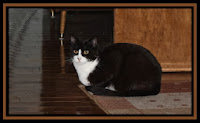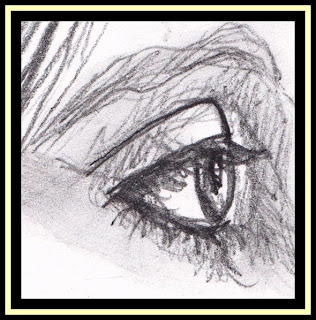
First, I prepare the glass for the paint by using a prep fluid I buy at Michael's and let it dry overnight.
For the next step, I sometimes prepare a design in advance and draw it on a white piece of paper which I put behind the glass as a guide (only works with clear glass this way...). And you can also draw on the glass with permanent ink that is not too slippery. Just make sure that the liquid leading completely covers your guide lines... The other side effect of drawing directly on the glass is that you see the lines through the other side, which I don't like, so I don't do that myself.
-Usually though, I play it by ear and do the drawing using the liquid leading that I apply to the glass. The initial drawing is very, very simple, like the photo at left, because applying the coloured paint always goes over the initial lines, so I have to redo the lines again after the coloured glass panes are done. This also makes sure that the leading ends up being raised like real leading which increases its similarity to real stained glass visually.
I have pen tips that I screw onto the tops of the liquid leading bottles I buy at Michaels. These allow me to create much finer lines than what the bottles of liquid leading create originally. I bought the pen tips at Michaels as well, but I have no idea what they are designed to be used for normally though.
I usually buy frames with glass on sale and use those myself. What I've done is remove all the backing from the glass in the frame, then put glazier's putty (available from some hardware stores, it's grey in colour and dries fairly stiff over time) over the edges of the glass and then put small pieces of wood over the putty and paint the wood black. Once the putty dries, the wood is securely held in place, just like a window frame...
Sometimes, (when I have the time and money), I put another layer of glass over the back of the glass again, with special glass that filters ultravoilet light out to preserve an especially good glass work that I want to hang in a west facing window that get a lot of light. Direct sunlight when the sun is especially bright can fade the colours over time, so this helps a lot. But it can get expensive.
 Back to the process itself.
Back to the process itself.
I have many bottles of glass paint that I use for the painting, you can use qtips and toothpicks to refine what you've put down on the glass for coloured areas, I used to use the toothpicks a lot to remove bubbles in the glass paint layer at the beginning, but now, I find the even side to side motion I use works just as well. But this stroke has to be very even in motion to avoid bubbles, and never, ever shake the bottles or it will take overnight for the bubbles to settle out of the paint. Otherwise, you end up with a paint that ensures bubbles over every square inch. Which, now that I think it over, could an interesting effect in itself!
I use many layers and overlapping colours to create shading and visual interest and also to avoid that plastic/fake look that I dislike so much!
Different paints give varying levels of opacity and translucency, so you've got a large range to play with. I use cameo ivory and white pearl for dotting a lot because they are fairly opaque and give nice effects.
Once the paint layers have dried, I use liquid leading over top to clean up the painting and smooth out the finished product. I use it to balance the composition if necessary, and correct any air bubbles I might have missed by putting in new divisions of paints to hide them. I add different colours to the new panes so that it looks like I planned the 'accidents' as part of the original composition. I often end up with something new and totally different that I like much, much more.
Once I'm satisfied, I leave the painting dry for a week, and then varnish it with glass varnish (two coats), to protect it from the elements and allow it to be washed with gentle soap and water in the future.
Slate Blue is pretty transparent and it's great for shading
other colours because it gives a nice, attractive shadowy effect, as does charcoal black and champagne.
Amber is one of my favourite underpainting colours because it works with pretty well everything as well as by itself.

Rose is especially beautiful and mixes well as well... High colour paints that work well are morning glory, aqua, fresh lime, sapphire, ruby red and so on. But I'm pretty careful with those, because the larger the area of high colour, and the smoother it is, the faker it looks. I also use crackle a lot to create texture in larger areas, it work extremely well and gives a close match to a lot of stained glass textures.
As you can see by the glass painting at right, I used a lot of very bright red in large panes in the composition. To combat the fake plastic look that I initially ended up with, I used dotting of another paint colour to texture the panes and give visual interest. It also made it reminiscent of pointellism or ink drawing by using the dots, which made it attractive.
Putting crackle over a paint layer that is dry, cracks the paint evenly, giving one style of effect. Putting it on a wet layer, cracks it so that the edges get extra paint stuck in it, so it's almost like bolding the broken edges, putting wet paint over dry crackle areas give pools of darker paint in the cracks, and put wet paint over wet crackle layers gives the same effect as layering them in the opposite order. There are other types of glass paints like crackle that give textures available, but I haven't really experimented with them much as they don't appear to work as well as crackle does...
Once the paint layers have dried, I use liquid leading over top to clean up the painting and smooth out the finished product. I use it to balance the composition if necessary, and correct any air bubbles I might have missed by putting in new divisions of paints to hide them. I add different colours to the new panes so that it looks like I planned the 'accidents' as part of the original composition. I often end up with something new and totally different that I like much, much more.
Then, I leave the painting dry for a week, and varnish it with glass varnish (two coats), to protect it from the elements and allow it to be washed with gentle soap and water in the future.
 I feel sorry for the cats, but on some level, I know they deserve it;-)
I feel sorry for the cats, but on some level, I know they deserve it;-)


















































